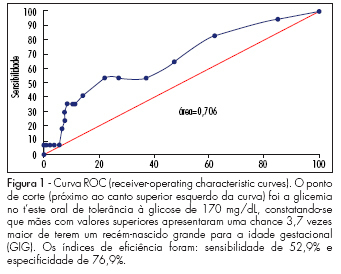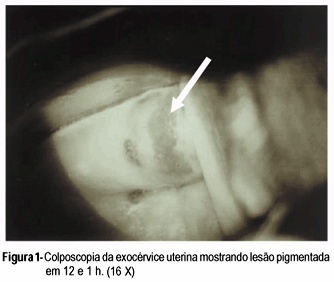Summary
Revista Brasileira de Ginecologia e Obstetrícia. 2009;31(1):5-9
DOI 10.1590/S0100-72032009000100002
PURPOSE: to evaluate factors related to the presence of neonatal macrosomia in pregnant women with gestational diabetes mellitus. METHODS: 157 pregnant women presenting gestational diabetes mellitus in follow-up were retrospectively selected from January 2004 to July 2006. This group has been divided into two subgroups: one with newborns with weight in accordance with the gestational age (n=136) and another with macrosomic newborns (n=21). Maternal characteristics have been compared between the groups. The t-Student test was used for the analysis of equality hypothesis between the averages of the two groups, and chi-square test, to check the groups' homogeneity concerning ratios. RESULTS: the groups did not show any significant difference concerning the gestational age, body mass index, weight gain along the gestation, number of previous pregnancies, fast glycemia in the oral glucose tolerance test after the ingestion of 75 g (TOTG 75 g), gestational age at delivery, glycemic values during the treatment, and the type of treatment used (p>0.05). In the group with neonatal macrosomia, there was a higher two-hour-glycemia in the TOTG 75 g (p=0.02), higher gestational age at the treatment onset (p=0.02), and a lower number of appointments at the health service (p<0.01). When adjusted to a logistic regression model, the most important factor (p<0.01) found to predict neonatal macrosomia was the two-hour-glycemia in the TOTG 75 g. CONCLUSIONS: the factors more frequently related to neonatal macrosomia were late treatment onset and, consequently, lower number of appointments and chiefly, high two-hour-glycemia in the TOTG 75 g.

Summary
Revista Brasileira de Ginecologia e Obstetrícia. 2008;30(1):5-11
DOI 10.1590/S0100-72032008000100002
PURPOSE: to study the value of Doppler velocimetry of the ductus venosus, between the 11th and 14th weeks of pregnancy, associated to the nuchal translucency thickness measurement, in the detection of adverse fetal outcome. METHODS: a transversal and prospective study in which a total of 1,268 fetuses were studied consecutively. In 56 cases, a cytogenetic study was performed on material obtained from a biopsy of the chorionic villus and, in 1,181 cases, the postnatal phenotype was used as a basis for the result. In addition to the routine ultrasonographic examination, all the fetuses were submitted to measurement of the nuchal translucency thickness and to Doppler velocimetry of the ductus venosus. Aiming at prevalence and accuracy indices, sensitivity, specificity, positive predictive value, negative predictive value, probability of false-positive, probability of false-negative, reason of positive probability and reason of negative probability were calculated and analyzed. RESULTS: from the total of 1,268 fetuses, 1,183 cases were selected for analysis. From this number, 1,170 fetuses were normal (98.9%) and 13 fetuses presented adverse outcome at birth (1.1%), including fetal death (trisomy 21 and 22) in two cases; genetic syndrome (Nooman) in one case; two cases of polymalformed fetuses; cardiopathy in three cases; and other structural defects in five cases. The prevalence of the modified ductus venosus (wave A zero/reverse) in the studied population was of 14 cases (1.2%), with a false-positive rate of 0.7%. CONCLUSIONS: there is a significant correlation between the alteration of the ductus venosus Doppler velocimetry and the thickness of the nuchal translucency as an ultrasonographic marker for the first trimester of gestation, in the detection of adverse fetal outcome, especially serious malformations. The ductus venosus was able to diminish the false-positive result in comparison to the isolated use of the nuchal translucency thickness, improving considerably the positive predictive value of the test.
Summary
Revista Brasileira de Ginecologia e Obstetrícia. 2014;36(1):5-9
DOI 10.1590/S0100-72032014000100003
To analyze and compare the knowledge, attitudes and opinions of medical students about abortion in Brazil during the progression of the course.
This was a cross-sectional study involving 174 medical students. A questionnaire was applied whose dependent variables were degree of information about abortion, including its legal aspects in Brazil, situations in which the students would agree with the expansion of permitted legal abortion, knowledge of someone undergoing abortion, and discomfort about performing the procedure legally. The independent variables were sociodemographic data, religion, and academic standing (first or second half of the course). For data analysis it was used χ2 and Fisher's exact tests, with the level of significance set at 5%.
Among the interviewees, 59.8 % considered themselves well informed about the topic. Students demonstrated knowledge about the complications of abortion, with no differences with the progression of the course. Knowledge about the legal aspects of abortion in Brazil was shown by 48.9% of the sample, being significantly higher among students in the second half of the course (34.0 and 68.9%, respectively; p<0.001). Experiencing situations of clandestine abortion was significantly higher among students in the final half of the course (3.05 and 59.4%, respectively; p<0.001), the same being observed about knowing someone who underwent the procedure illegally (5.0 and 18.9%, respectively; p<0.001). The expansion of permissive legal abortion in Brazil was agreed about by 86.2% students, although 54.6% of the students reported that they felt uncomfortable about performing the procedure even legally, without statistical significance with the evolution of the course regarding the two situations.
The experiences of abortion and the knowledge of legal aspects were significantly higher among students in the second half of the course, with no significant changes in attitudes or opinions about abortion being observed with the competences acquired during medical training.
Summary
Revista Brasileira de Ginecologia e Obstetrícia. 2020;42(1):5-11
Estimate the prevalence of human herpesvirus type 1 HSV-1 DNA in placental samples, its incidence in umbilical cord blood of newborns and the associated risk factors.
Placental biopsies and umbilical cord blood were analyzed, totaling 480 samples, from asymptomatic parturients and their newborns at a University Hospital. Nested polymerase chain reaction (PCR) and gene sequencingwere used to identify the virus; odds ratio (OR) and relative risk (RR) were performed to compare risk factors associated with this condition.
The prevalence of HSV-1 DNA in placental samples was 37.5%, and the incidence in cord blood was 27.5%. Hematogenous transplacental route was identified in 61.4% from HSV-1+ samples of umbilical cord blood paired with the placental tissue. No evidence of the virus was observed in the remaining 38.6% of placental tissues, suggesting an ascendant infection from the genital tract, without replication in the placental tissue, resulting in intra-amniotic infection and vertical transmission, seen by the virus in the cord blood. The lack of condom use increased the risk of finding HSV-1 in the placenta and umbilical cord blood.
The occurrence of HSV-1 DNA in the placenta and in cord blood found suggests vertical transmission from asymptomatic pregnant women to the fetus.
Summary
Revista Brasileira de Ginecologia e Obstetrícia. 1998;20(1):50-52
DOI 10.1590/S0100-72031998000100009
Compound nevus of the uterine cervix is very rare. Benign and malignant melanotic lesions of endo and exocervix have been rarely documented. The present case of compound nevus in the uterine exocervix was found in a 47-year-old woman without gynecologic complaints. Diagnosis was suspected by colposcopic evaluation and confirmed trough histopathological examination. The treatment was concluded with total abdominal hysterectomy based on the possible malignant transformation of these lesions and the difficult patient follow-up.

Summary
Revista Brasileira de Ginecologia e Obstetrícia. 2014;36(2):50-55
DOI 10.1590/S0100-72032014000200002
To evaluate pregnancy outcome and thrombophilia frequency in women with recurrent
fetal death.
Evaluation of obstetric outcomes in a retrospective cohort of pregnant women with
recurrent stillbirth after the 20th week, from 2001 to 2013.
Antithrombin activity, protein C and S activity, factor V Leiden, prothrombin gene
mutation and antiphospholipid syndrome were analyzed.
We included 20 patients who had recurrent fetal death. Thrombophilia were found
in 11 of them, 7 diagnosed with antiphospholipid syndrome, 3 with protein S
deficiency and 1 with prothrombin gene mutation. All of them were treated with
subcutaneous heparin (unfractionated heparin or enoxaparina) and 14 of them with
acetylsalicylic acid (AAS) during pregnancy. Obstetric complications occurred in
15 patients and included: intrauterine fetal growth restriction (25%), placenta
previa (15%), reduced amniotic fluid index (25%), severe preeclampsia (10%), fetal
distress (5%), and stillbirth (5%). The mean gestational age at delivery was
35.8±3.7 weeks and newborn weight averaged 2,417.3±666.2 g.
Thrombophilia screening should be performed in all pregnant women with recurrent
fetal death after the 20th week as a way to identify possible causal
factors suitable for treatment.
Summary
Revista Brasileira de Ginecologia e Obstetrícia. 2019;41(8):500-507
The present study was conducted with the objective of investigating the effectiveness of solution-focused group counseling (SFGC) on promoting the mental health of midwifery students.
The present study is an intervention-based study with a pretest, a post-test, and a control group. The statistical population included all of the midwifery students studying in the midwifery department of the Bam University of Medical Sciences, Kerman, Iran, who filled out the General Health Questionnaire (GHQ) in the screening phase. In the second phase, 40 individuals, having a low level of mental health based on the cutoff score of 23, were selected and randomly divided into 2 groups (intervention and control), each group with 20 participants. The intervention group participated in 5 sessions of 75 minutes for SFGC. Then, the post-test was held in both groups and the data analysis was conducted using the Mann-Whitney and the Kruskal-Wallis test with IBM SPSS Statistics for Windows, Version 21.0 (IBM Corp, Armonk, NY, USA). The significance level was considered as p < 0.05.
The findings showed that the mean of the post-test mental health scores of the intervention group (14.5 ± 50.35) and of the control group (23.6 ± 35.83) showed a statistically significant difference (p < 0.0001). Moreover, the comparison between the mean scores of the mental health subscales (physical symptoms, stress, social performance, and depression) showed a statistically significant difference in these groups, and SFGC improved physical symptoms, stress, social performance, and depression in the members of the intervention group.
Solution-focused group counseling may improve all levels of mental health. This type of counseling is recommended to be used to solve the psychological problemsand to improve the mental health of students, as well as of the staff of the health system.